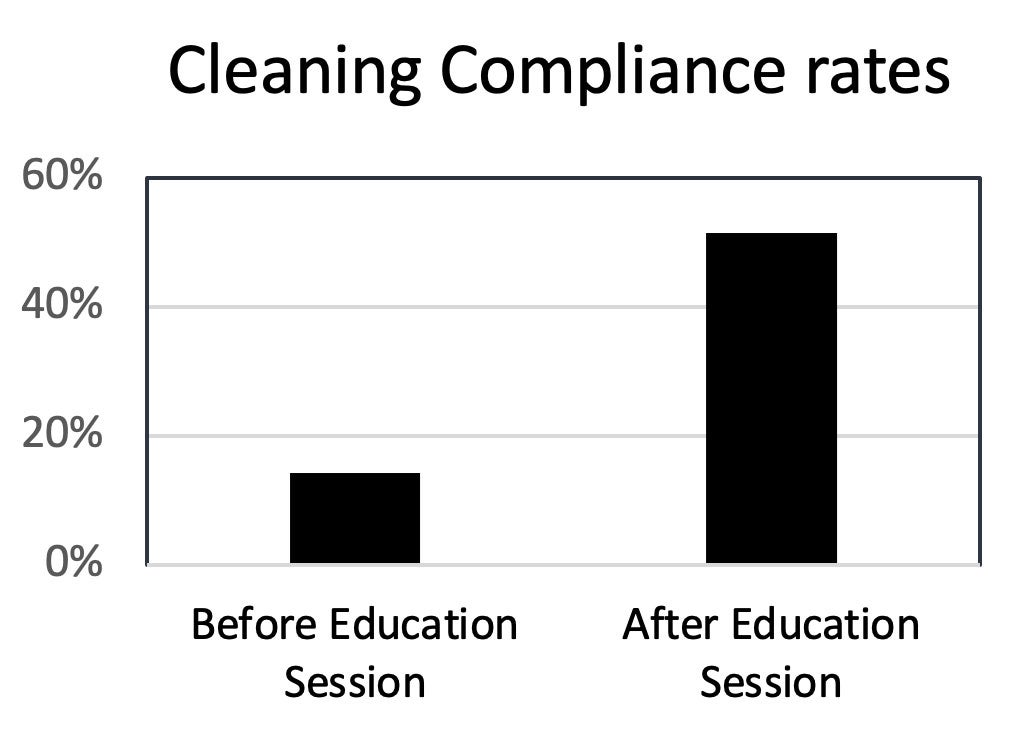Unlocking Potential: The Proof of the Value of Education & Training in Professional Cleaning

It’s a fact: Education and training leads to many positive outcomes in today’s workforce, including increased productivity, reduced turnover, and improved outcomes.1,2 I was reminded of this recently when I attended the Association for Talent Development’s annual conference (ATD23), which brought together over 10,000 attendees and 300 vendors from 50 countries, united in the vision of “creating a world that works better”. Yet, while the value of education and training are clearly understood by many, an excuse I hear often in the cleaning industry is that there is not time for it. This couldn’t be further from the truth. If you are a cleaning manager or supervisor and you are not prioritizing the education and training of your staff, you are missing out on a huge opportunity to benefit your business and organization by unlocking the full potential of your staff. Henry Ford said it well when he said, “The only thing worse than training your employees and having them leave, is NOT training them and having them stay.”
“Creating a world that works better”
Still not convinced?
In this blog, I’ll dive into some of the most recent peer-reviewed evidence that highlights the positive impact of education and training programs on cleaning operations. These studies are from healthcare, but the results can be applied to any setting. This is because many cleaning-for-health best practices are similar across building types. For example, front-line cleaners both in and outside of healthcare should be thoroughly cleaning the surfaces they have been assigned, they should always wipe in an s-shape pattern, and when disinfecting, they should always ensure the product stays wet for the contact time. I hope these studies, along with what the over 10,000 ATD23 attendees understand, will help you to find the time to educate and train your staff so that you can reap the many benefits as well.
“The only thing worse than training your employees and having them leave, is NOT training them and having them stay.”
Recent Published Studies
Study #1: An educational feedback session3
In this study, researchers examined how education can improve cleaning compliance in a healthcare setting. They used a fluorescent marker to assess if cleaning occurred on 700 surfaces in 35 inpatient rooms.
This study had three phases: a baseline assessment, an educational feedback session, and post-feedback assessment. They analyzed 350 surfaces in each assessment phase to measure compliance with cleaning and disinfection protocols.
Initially, during the baseline assessment, the compliance rate was low at 14.3%. This indicated inconsistent disinfection practices. After implementing the educational initiative and providing feedback, the compliance rate significantly increased to 51.4% in the post feedback phase.

Study #2: Education and training as part of structured system4
In this study, the hospital implemented a multi-pronged approach of education, training, monitoring, and feedback for the environmental services (i.e., healthcare cleaning operations, EVS) and infection prevention departments. The goal was to improve the cleaning practices and reduce the risk of infections in the healthcare setting.
To measure the effectiveness of this process, the researchers compared the cleaning performance before and after the implementation. Initially, the surface cleaning performance was at 74%. However, after the training program, the performance increased significantly to 90%, and it maintained at that level.
The positive impact of the training program was not limited to improved cleaning performance. The study also found that rates of C. diff infections decreased by 75%, indicating a significant reduction in the spread of this harmful bacteria.

Study #3: Special education sessions5
In this study, researchers examined 574 different surfaces in a dental school, over a period of three months. They also used a fluorescent marker to mark these surfaces. The purpose was to monitor how well these surfaces were being cleaned.
After the initial three-month period, the researchers shared their findings with the dental students, staff, and cleaning personnel during special education sessions. These sessions aimed to emphasize the importance of cleaning and disinfecting to prevent cross-contamination (the spread or transfer of germs from one area, surface, or person to another).
Following the educational sessions, the researchers continued their study for an additional three months. They re-examined 662 surfaces using the same method and the results were significant. They found statistically significant improvements in the cleanliness of the students’ dental cubicles, students’ x-ray areas, and elevator buttons, compared to their initial findings.

Surfaces with a statistically significant improvement in cleanliness after educational sessions
Conclusion
In conclusion, the ATD23 conference served as a powerful reminder of the value placed on education and training and it is clear from recent evidence that prioritizing education and training in the cleaning industry is also critically important. This is especially true as we are experiencing record levels of labor shortages and high turnover. With the emergency of the pandemic now behind us, I encourage you to act on the evidence and commit to making time for education and training for your staff. If you do, you will unlock their full potential, help ensure the continued success in your operation, and advance our important field.
Clorox Professional offers high-quality & FREE education and training, including:
- An ANSI National Accreditation Board-accredited training on Cleaning for Health and designed for frontline cleaners (available in both English & Spanish)
- A 20 min eLearning module on Cleaning and disinfecting in Healthcare and designed for EVS managers and supervisors.
- Several timely webinars, including Candida auris: An emerging threat in Long Term Care and Innovation in Green Cleaning, designed for Infection Preventionists and Cleaning Professionals both in and outside of healthcare.
Unlock your team’s potential by using our education & training to supplement your current programs!
To learn more or sign up, visit our website at www.cloroxpro.com/healthyclean and https://www.cloroxpro.com/educational-courses/
References
1. Arthur W. Jr., Bennett W. Jr., Edens, PS, Bell ST. Effectiveness of training in organizations: A meta-analysis of design and evaluation features. Journal of Applied Psychology [Internet].2003; 88(2), 234–245. [cited 2023 Jun 20] Available from: https://psycnet.apa.org/record/2003-03332-006
2. PwC. Navigating the rising tide of uncertainty. 23rd Annual Global CEO Survey [Internet]. 2020. [cited 2023 Jun 20] Available from: https://www.pwc.com/gx/en/ceo-survey/2020/reports/pwc-23rd-global-ceo-survey.pdf
3. Fram DS, Medeiros EA, Ribeiro RM, Escudero DVdS, Alves JCD, Macedo B, Ferreira DB, de Oliveira AHV, Santos RP, Matias LdO, Maia MM, Freires FJC, Ferreira VM, de Almeida TML, Machado FR. High-touch surfaces disinfection compliance in a COVID-19 intensive care unit. American Journal of Infection Control [Internet]. 2023; 51(4), 469–471. [cited 2023 Jun 20] Available from: https://www.ncbi.nlm.nih.gov/pmc/articles/PMC9444321/
4. Parry MF, Sestovic M, Renz C, Pangan A, Grant B, Shah AK. Environmental cleaning and disinfection: Sustaining changed practice and improving quality in the community hospital. Antimicrobial Stewardship & Healthcare Epidemiology [Internet]. 2022; 2(1), e113. Available from: http://pubmed.ncbi.nlm.nih.gov/36483421/
5. Dolev E, Eli I, Mashkit E, Grinberg N, Emodi-Perlman A. Fluorescent Marker as a Tool to Improve Strategies to Control Contaminated Surfaces and Decrease Danger of Cross-Contamination in Dental Clinics, during and beyond the COVID-19 Pandemic. International Journal of Environmental Research and Public Health [Internet]. 2023; 20(6), 5229. [cited 2023 Jun 26]. Available from: https://www.ncbi.nlm.nih.gov/pmc/articles/PMC10049276/






